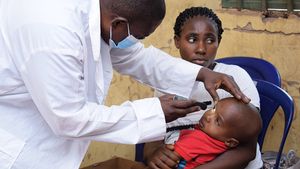Transgender women are the fastest-growing population of HIV-positive people in the country, according to Miss Major, a 70-year-old transgender woman of color and the executive director of TGI Justice Project, a San Francisco–based advocacy organization that fights for the rights of transgender, intersex, and gender-variant people who are in prison or have served jail time.
Most experts agree with Major’s assertion, but hard data backing up that reality is hard to come by since HIV data collection methods often either mistakenly categorize transgender women as men who have sex with men, or don’t distinguish between transgender and nontransgender women.
This kind of systematic mislabeling and ignorance is a grim reality for many trans women, says Major. Medical professionals, police officers, and even gay and lesbian communities “go out of their way to crush us so that we feel ignored and rejected, and that our wishes and desires don’t count,” Major says. “There is no care for who we are and what we do.”
The data validates Major’s concerns. A 2009 report from the National Institutes of Health found that nearly a third of transgender Americans are HIV-positive. The study also indicated that many transgender women may not know their HIV status, due to a series of cultural, social, and economic barriers.
Transgender women of color are at an even greater risk for HIV infection than their white peers. The NIH study noted that African-American and Latina transgender women had the highest infection rates; among those transgender women of color surveyed, more than 56% of black trans women were HIV-positive, and Latina trans women had an HIV infection rate of 16%.
Transgender women often require regular hormone therapy, and many of those who can afford the out-of-pocket expense undergo various forms of gender-reassignment surgery. But with multiple medications necessary already (such as estrogen, which must be taken weekly), HIV-positive trans women are less likely to regularly use antiretroviral medication than are their nontransgender peers. The NIH study, which focused on a clinic in New York City, reported that transgender women were often concerned that HIV medication would interfere with their hormone therapy. One woman told NIH researchers that many of her fellow HIV-positive trans women prioritized hormone therapy over HIV medication: “They feel that the HIV meds would mess with the hormones, and by them being transgender, they want the hormones to work OK.”
A great deal of the medication and treatment these women need is not covered by insurance, and is often costly and difficult to obtain. To make matters worse, antidiscrimination laws rarely cover transgender women.
“In the majority of the states in the U.S., it’s legal to discriminate on the basis of gender identity,” says JoAnne Keatley, director of the Center of Excellence for Transgender Health at the University of California, San Francisco. “You can deny a person employment or you can terminate someone who is transitioning on the job merely because they are transgender.”
That kind of discrimination has a devastating effect on the economic well-being of transgender people. According to a 2011 report from the National Center for Transgender Equality, transgender people were four times more likely than the general population to live in extreme poverty, with a household income less than $10,000 a year, and more than twice as likely as the general population to be homeless. A staggering 90% of the 6,450 transgender people surveyed nationwide reported being the target of harassment, mistreatment, or discrimination at work.
This complex web of intertwining oppression and discrimination leaves many transgender women with no option to support themselves but to turn to underground employment—most frequently by engaging in sex work.
“We have to scrounge for housing, and it puts us in the street at night to cover what we need to cover during the day,” explains Major. “It’s kind of like a merry-go-round that we’re on, and it’s difficult to stay [HIV-] negative.”
Cyd Nova, the harm reduction coordinator at San Francisco’s St. James Infirmary, a clinic for current and former sex workers, agrees that trans women are often forced to turn to sex work to support themselves.
“Sex work is a form of labor available to people who may not have many other options,” says Nova. “Sex work is also a means of empowerment for a community that often has high financial needs.”
But the effort to meet those needs runs into problems with the criminalization of sex work, which hits transgender women particularly hard. Police officers sometimes target trans women, and in several major U.S. cities, use the presence of multiple unused condoms as evidence of prostitution.
“Trans women are disproportionately profiled and targeted by law enforcement for harassment and arrest,” says Nova. “And because of policies like [using] condoms as evidence, trans women often face a choice between protecting themselves and their partners from HIV and risking arrest.”
Incarceration also plays a role in the high HIV rates. When a trans woman is arrested and jailed for prostitution—or any other crime—many prisons will house her with male inmates. Other jails keep trans prisoners in solitary confinement, often only releasing the inmate from her cell for an hour or so each day, presumably for her protection.
“Once a trans person becomes part of that cycle of criminal injustice, it’s hard to break out of that,” says Keatley.
While sex workers in general are more likely to be HIV-positive than those who do not engage in sex work, transgender female sex workers are at four times greater risk for contracting HIV than other female sex workers, according to an international analysis published in 2008 in the Journal of Acquired Immune Deficiency Syndromes.
Further complicating efforts to combat HIV among transgender people is that population’s basic lack of access to medical care. The 2009 NIH study examined one community-based health clinic in New York City and identified a number of reasons that transgender women aren’t seeking preventive health care, including limited access to low-cost care and safe, trans-inclusive medical environments, along with the incompetence of many doctors about basic transgender health care, which results in trans women feeling unsafe to disclose their HIV status.
The combination of social stigma, institutional discrimination, economic hardship, and distrust of medical professionals creates a major barrier to connecting transgender women with HIV-related care.
“Not much HIV-prevention messaging is aimed toward or accessible to trans people,” says Nova. Noting that most HIV-prevention programming is for gay and bisexual men, Nova argues that current prevention efforts don’t meet the needs of HIV-positive trans women.
When this reality is layered with the medical profession’s lack of understanding around transgender health care, the result is an identity that is stigmatized and often treated as psychiatric illness. Given that, Nova says, “it is no wonder that trans people are hesitant to come into contact with HIV care, which in turn multiplies the risk of transmission.”













































































